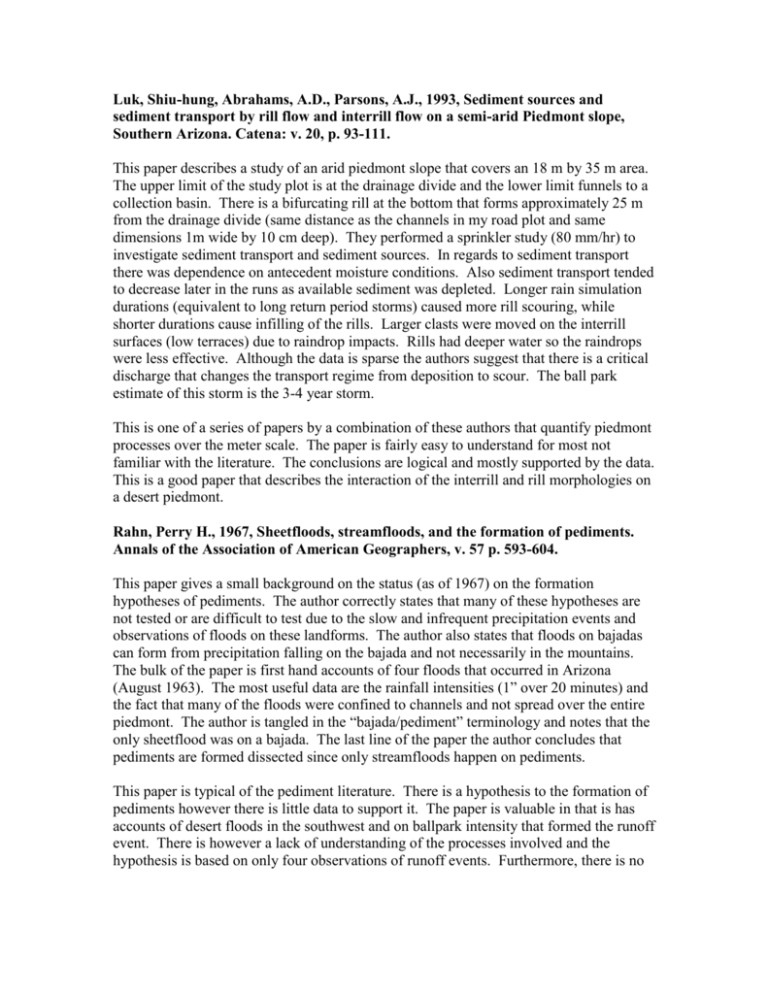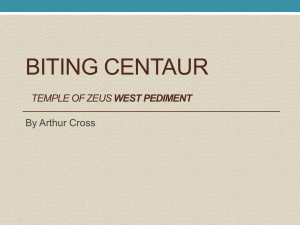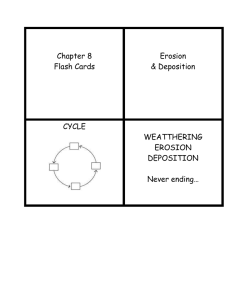Piedmont
advertisement

Luk, Shiu-hung, Abrahams, A.D., Parsons, A.J., 1993, Sediment sources and sediment transport by rill flow and interrill flow on a semi-arid Piedmont slope, Southern Arizona. Catena: v. 20, p. 93-111. This paper describes a study of an arid piedmont slope that covers an 18 m by 35 m area. The upper limit of the study plot is at the drainage divide and the lower limit funnels to a collection basin. There is a bifurcating rill at the bottom that forms approximately 25 m from the drainage divide (same distance as the channels in my road plot and same dimensions 1m wide by 10 cm deep). They performed a sprinkler study (80 mm/hr) to investigate sediment transport and sediment sources. In regards to sediment transport there was dependence on antecedent moisture conditions. Also sediment transport tended to decrease later in the runs as available sediment was depleted. Longer rain simulation durations (equivalent to long return period storms) caused more rill scouring, while shorter durations cause infilling of the rills. Larger clasts were moved on the interrill surfaces (low terraces) due to raindrop impacts. Rills had deeper water so the raindrops were less effective. Although the data is sparse the authors suggest that there is a critical discharge that changes the transport regime from deposition to scour. The ball park estimate of this storm is the 3-4 year storm. This is one of a series of papers by a combination of these authors that quantify piedmont processes over the meter scale. The paper is fairly easy to understand for most not familiar with the literature. The conclusions are logical and mostly supported by the data. This is a good paper that describes the interaction of the interrill and rill morphologies on a desert piedmont. Rahn, Perry H., 1967, Sheetfloods, streamfloods, and the formation of pediments. Annals of the Association of American Geographers, v. 57 p. 593-604. This paper gives a small background on the status (as of 1967) on the formation hypotheses of pediments. The author correctly states that many of these hypotheses are not tested or are difficult to test due to the slow and infrequent precipitation events and observations of floods on these landforms. The author also states that floods on bajadas can form from precipitation falling on the bajada and not necessarily in the mountains. The bulk of the paper is first hand accounts of four floods that occurred in Arizona (August 1963). The most useful data are the rainfall intensities (1” over 20 minutes) and the fact that many of the floods were confined to channels and not spread over the entire piedmont. The author is tangled in the “bajada/pediment” terminology and notes that the only sheetflood was on a bajada. The last line of the paper the author concludes that pediments are formed dissected since only streamfloods happen on pediments. This paper is typical of the pediment literature. There is a hypothesis to the formation of pediments however there is little data to support it. The paper is valuable in that is has accounts of desert floods in the southwest and on ballpark intensity that formed the runoff event. There is however a lack of understanding of the processes involved and the hypothesis is based on only four observations of runoff events. Furthermore, there is no evidence that the current processes are in any way related to the processes that formed the pediment. Pohl, Molly M., 1995, Radiocarbon ages on organics from piedmont alluvium, Ajo Mountains, Arizona. Physical Geography, vol., 16, p. 339-353. This paper dates two alluvial terraces of a desert piedmont using 14C. The higher terrace dates ~14,900 ybp (one sample) while the younger one dates ~2500 ybp (two dates). The dates are from marcofossils that were wet sieved from 10kg of sediment. The dates are in accordance with the soil development for the arid southwest. The author tries to correlate the infilling of the older terrace with Heinrich events. There is also order of magnitude discussion of sediment transport rates by dating the terrace age and using cosmogenic 36Cl. Such transport events are on the order of 10,000 to 85,000 years. This paper has nuggets of good ideas, but the basing climatic implications on two small terraces and only three dates seems a bit optimistic to me. There are several assumptions in the paper to start to correlate deposition periods in Arizona with the Heinrich events. Even, more troubling is that the younger terrace does not correlate with the paleoflood history of Arizona. Too bad I cannot find any follow up on the techniques that are discussed in this paper…maybe that tells you something. Vincent, Peter, Sadah, Ahmad, 1995, Particle size-pediment slope relations: some findings from Saudi Arabia. Catena, vol., 24, p. 91-103. This paper’s main thesis is to challenges Cooke’s idea of debris size controlling slope of the landform. The authors further point out that one should not lump pediments and mountain faces together as Cooke et al. The sediment measured in Saudi Arabia ranged from –3.5 phi to 14 phi. The statistics of 108 sediment samples show that piedmont slope and grain size is not correlated. Piedmont slope decreases faster than average grain size, probably due to input of aeolin fines and/or weathering of rock in situ, and the fact that granite disintegrates rather quickly. These results and a re-computation of Cooke’s data using the same statistical analysis also show the piedmont slope and the decrease in grain size is not statistically significant. This paper relies heavily on statistics to back up their thesis. I have no doubt as to their results, but I don’t really see why this is so important. This paper does not shed any light on pediment processes. Vincent, Peter, Sadah, Ahmad, 1995, Downslope changes in the shape of pediment debris, Saudi Arabia. Sedimentary Geology, vol., 95, p. 207-219. This is the same basic idea that the previous paper discusses. The conclusions of this paper are that clasts become more rounded down slope and that they become more speroid, rather than bladed. The pediments that they studied ranged from 400 to 1250 m long. There is mixed signals about the fluvial activity not transporting the sediment very far, but then at the end of the paper they say that basalt clasts (that only outcrop as a capping layer in the Mountains) are all the way down the pediment, so therefore there must have been extensive transport. I believe that many of the results such as clast shape and roundness are strongly associated with lithology. The authors however did not separate out the different lithologies and lumped all the data together. From their data the authors confirm fluvial activity and that it is unlikely that the pediments in question are simply inherited deep weathering paleoforms. I don’t know how they can support this claim. The paper is fairly easy to read. Effective use of statistics shows that overall clasts do become more rounded down pediment. I feel, however, that simple separation of clast lithologies would be more valuable to looking at clasts on pediments. Furthermore, clast sources are present all the way down the pediment so I am not sure what the importance of clasts shape is. I also think that the data only weakly supports some of the discussion section if at all. Williams, George E., 1973, Late Quaternary piedmont sedimentation, soil formation and paleoclimates in arid South Australia. Zietschrift Fur Geomorphologie, vol., 17, p. 102-125. This paper gives a detailed Quaternary history of an area in SW Australia. The history is based on field mapping and relationships and on radiocarbon dates of wood and of calcium carbonate layers in the soil. Many of the dates are pushing the limits of the technique and are > 30,000 years old. I am also not too sure of the technique of dating carbonate. Seems like samples could easily be contaminated and give old dates. The first part of the paper does not discuss process, it gives a laundry list of local geologic formation names and dates. Edinger-Marshall, S.B., Lund, L.J., 1999, Gravel Dispersion on a granite pediment (East Mojave Desert, California): A short-term look at erosional processes. Earth Surface Processes and Landforms, vol., 24, p. 349-359. This paper discusses the dispersion of sediment on a pediment surface (10s of meters) after one season of rainfall. They used painted pebbles as the pebble tracing method. Most of the movement was caused by rainsplash and not by overland flow. They tested three hypotheses: 1) similar movements would be found regardless of surface shape, 2) similar movements would be found regardless of landscape position, 3) surface gravel movements are similar regardless of vegetation cover. The first hypothesis was supported by the data. The data were not separable according to convex, concave, or flat surfaces. The second hypothesis was rejected. Different landform groups had different movements (e.g. wash sediment traveled the farthest; summits farther than backslopes). The third hypothesis was also rejected. Sediment under vegetation canopies traveled the least; in fact the sediment that traveled under the canopy covered the other sediment so there was a net flux of sediment under the veg. which constructed a mound. This paper shows the short-term, small-scale sediment movement on pediments due to rainsplash. The results are interesting but it does not address the long-term or large-scale questions associated with pediments. Furthermore, this paper does not address the dominate process on many piedmonts, overland flow. Twidale, C.R., 1979, The character and interpretation of some pediment mantles. Sedimentary Geology, vol., 22, p. 1-20. This is a lengthy paper on pediments in southern Australia. Unlike most pediment papers, this paper discusses pediments that form on lithologies other than crystalline granitic rocks. This paper is also one of the first to discuss the sediment covered pediments. Twidale discusses the Brachina pediment and the Italowie pediment as being, “formed under running water…in a manner analogous with that suggested by McGee…” i.e. sheetfloods. Twidale, makes the statement that silicrete suggests pediments are middle Tertiary in age. I don’t know how this claim is substantiated. Twidale suggests that not all course debris on pediments is from fluvial action. Such debris can come partly from earthquakes. I think Twidale is stretching his data too far when he hypothesizes the formation mechinism of the pediment…“Running water is most likely responsible for both the sculpture of the plante forms and the downslope transport of fines, but these are inferences rather than conclusions based on field evidence.” I agree with Twidale that the Flinders Ranges (multiple lithologies) and granite areas are different. He further states that the granite areas have smaller catchments and less of a soil mantle, and that there is no coarse sediment to act as a protective veneer. I feel that lithology plays a major role in these differences, not that the granite pediments have anthropogenic influence that has eroded the mantle. Overall I like the idea of looking at soil mantles but I think the author places too much emphasis on the mantles when he states that mantles tell how they originated, how the sediment was transported and what processes are active on bedrock. This is a long paper that has many hypotheses that are not based on much data. Many of the examples as stated as fact are self referenced. There are many statements that I find hard to agree with. On the other hand, Twidale does discuss the importance of pediment mantles and the idea that not all pediments have to be bare rock surfaces. Such thinking opens new possibilities as to the development of pediments. Twidale, C.R., and Bourne, J.A., 2000, A note on the role of protection in landform development: examples from granitic terrains. Zietschrift Fur Geomorphologie, vol., 44, p. 195-210. This is a qualitative paper on how some unusual granitic landforms are developed. The main mechanism is the lack or concentration of water causing preferential weathering. Some of the ideas are logical, while I disagree with other ideas. For example, folded mountain belts “persist” due to water running off of the summit and settling in the valley. The lack of water at the headwaters cause little erosion while there is enhanced weathering in the valley. This would make relief and the positive feedback would cause thousands of Himalayian stature mountains around the world. What about the core of mountain belts where there is no significant relief anymore? In the rest of the paper the authors describe certain rock landforms and how they are caused by water. The authors state five types of water deprivation: Shedding of water (off of bedrock), shielding, the umbrella effect, diversion of runoff on basal slopes, biotic protection, and permeable cover. This paper is easy to read in that there is not quantitative formula that one would encounter in other specialized geomorphology fields. The paper is difficult to follow in that there are specialized terms that many would not be familiar with. Furthermore, the landforms discussed in the paper are not common landforms that show up in all desert landscapes. Mackin, J.H., 1970, Orgin of pediments in the western United States. In Problems of Relief Plantation, Pecsi, Matron Ed. Akademiai Kiado, Budapest. P. 85-105. This paper is from an international conference on plantation surfaces. The author is the only from the United States that discussed desert piedmonts. The paper is taken almost verbatim from Mackin’s presentation in April 1968 before his death in August 1968. Definition of pediment: erosional surface over hard rock or unconsolidated sediments of any origin, planar, low local relief, slope of transportation, it can be dissected or buried or greatly modified by processes other than those that formed it. Dominant processes are corrosion, weathering and washing…creep is negligible. Gravel veneers are not necessarily a sign of aggradation…”a stream cannot shift laterally without leaving behind a sheet of alluvium the thickness of the which tends to approach the maximum depth of the flood scour channel.” Such an example is a pediment formed by lateral plantation. Lateral plantation pediments can range from continuous surfaces to stream cut valley floors or terraces that are remnants of such valley floors. High gradient, low discharge streams are far more effective agents of bed load transportation and corrosion than low gradient, high discharge streams. Good explanation of this for desert systems. An example of pediments formed by weathering and washing is the Three Peakes intrusion of southwestern Utah and of course, Cima Dome. The Three Peaks pediment is chiefly grus and there are no cut banks. The sediment is moved short distances by sheet floods (a few hundred meters). The rare 2 to 5 year flood controls the slope and flows down the entire slope to its base. Mackin describes three types of mountain fronts in relation to the pediment problem 1)resistant rock overlies weak rock (shale)…differential erosion…no problem 2) resistant rock dips under weak rock abutting core of igneous rock…again differential erosion (hog back formation)…no problem. 3) igneous rock…maybe a difference in mineralology? Main problem is pediment angle. Lateral corrosion and parallel retreat of the mountain front. Steep slopes have big boulders with when roll down slope shatter into grains…or retention of moisture in a mantle. Not a problem only when we try to use one explanation for all mountain fronts. Shape of pediment parallel to mountain front. Hasn’t really been looked at and Mackin doesn’t really say much about it here either except that in profile they can be from concave up, to convex, to flat. This is an easy read. This paper is an excellent review of many of the processes thought to be responsible for pediment formation up to the late 1960s. In fact, there are no real new processes presented since this paper was written. Although this paper does not really present any knew ideas or data it is a good review of pediment and a good introduction to the geomorphologist not familiar with the pediment hypotheses. Smith, G.A. Recognition and significance of streamflow-domintated piedmont facies in extensional basins. Basin Research: vol., 12, p. 399-411. This paper presents an idea that alluvial slopes should be considered as an separate and distinct landform from alluvial fans and pediments. The morphologies are different and the argument is that the sedimentology is also different. Alluvial slopes are characterized by parallel stream channels rather than by radial streams. Flow regimes are dominated by channelized flow rather than sheet flow of alluvial fans. Sedimentological analysis of two basins in the Basin and Range suggest channelized flow of an alluvial slope. It is hypothesized that alluvial slopes should form where mountain fronts do not have abrupt structural and topographic definition. Two topographic and structural examples would be along tectonically inactive and embayed mountain fronts and on the hanging wall ramp side of half grabens. This is a great paper in support of the surfaces that I am working on. The focus of the paper has to do with sedimentological implications rather than process implications. It does show that alluvial slopes can have extensive depositional histories. Furthermore, this paper might give some ideas to test the cosmo sediment transport on other piedmonts…Tortilta Mountains, south-east Arizona into the Santa Cruz river floodplain. Balchin W.G. and Pye, N., 1955, Piedmont profiles in the arid cycle. Proceedings of the Geologists’ Association, vol., 66, p. 12-167-181. This paper describes as of the 1950s the status of knowledge on desert piedmonts. It starts giving the common definitions for the landforms…bajadas, pediment, mountain front, alluvial zone including peripediment.







